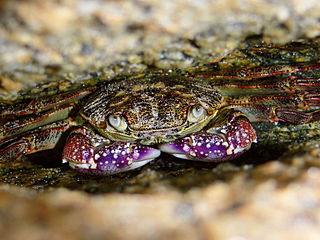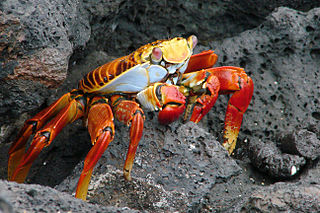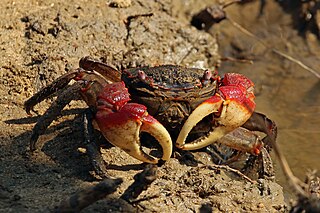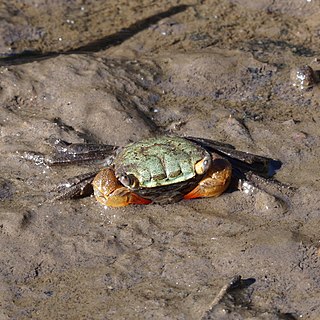
Crabs are decapod crustaceans of the infraorder Brachyura, which typically have a very short projecting "tail" (abdomen), usually hidden entirely under the thorax. They live in all the world's oceans, in freshwater, and on land, are generally covered with a thick exoskeleton, and have a single pair of pincers on each arm. They first appeared during the Jurassic Period.

The Decapoda or decapods are an order of crustaceans within the class Malacostraca, and includes crabs, lobsters, crayfish, shrimp, and prawns. Most decapods are scavengers. The order is estimated to contain nearly 15,000 extant species in around 2,700 genera, with around 3,300 fossil species. Nearly half of these species are crabs, with the shrimp and Anomura including hermit crabs, porcelain crabs, squat lobsters making up the bulk of the remainder. The earliest fossils of the group date to the Devonian.

Anomura is a group of decapod crustaceans, including hermit crabs and others. Although the names of many anomurans include the word crab, all true crabs are in the sister group to the Anomura, the Brachyura.

Raninoida is a taxonomic section of the crabs, containing a single superfamily, Raninoidea. This group of crabs is unlike most, with the abdomen not being folded under the thorax. It comprises 46 extant species, and nearly 200 species known only from fossils.

The Ocypodidae are a family of semiterrestrial crabs that includes the ghost crabs and fiddler crabs. They are found on tropical and temperate shorelines around the world.

Thoracotremata is a clade of crabs, comprising those crabs in which the genital openings in both sexes are on the sternum, rather than on the legs. It comprises 17 families in four superfamilies .

The Grapsidae are a family of crabs known variously as marsh crabs, shore crabs, or talon crabs. The family has not been confirmed to form a monophyletic group and some taxa may belong in other families. They are found along the shore among rocks, in estuaries, marshes, and in some cases pelagic among drifting seaweeds and flotsam.
Cyclodorippoida is a group of crabs, ranked as a section. It contains the single superfamily Cyclodorippoidea, which holds three families, Cyclodorippidae, Cymonomidae and Phyllotymolinidae.

Perisesarma is a genus of mangrove crabs in the family Sesarmidae predominantly found in the Indo-Pacific. Some 23 species are described as of late 2006, with two from West Africa: P. kammermani(De Man, 1883) and P. albertiRathbun, 1921. They are typically small, semiterrestrial crabs found on the forest floor at low tide. They eat nearly anything they can, and try to eat anything that does not threaten them — including pencils and other objects dropped on the forest floor. The last species of the genus described is P. samawatiGillikin and Schubart (2004). It can be found in East Africa along with P. guttatum, but its sister species is P. eumolpe from Malaysian mangroves.

Dromioidea is a superfamily of crabs mostly found in Madagascar. Dromioidea belongs the group Dromiacea, taxonomically ranked as a section, which is the most basal grouping of Brachyura crabs. Dromiacea likely diverged from the rest of Brachyura around the Late Triassic or Early Jurassic, and the earliest fossils attributable to the Dromioidea date from the Late Jurassic.

The Sesarmidae are a family of crabs, previously included in the Grapsidae by many authors. Several species, namely in Geosesarma, Metopaulias, and Sesarma, are true terrestrial crabs. They do not need to return to the sea even for breeding.

Sesarma is a genus of terrestrial crabs endemic to the Americas.

Parasesarma erythrodactyla, also known as the red-handed shore crab, is a burrowing crab inhabiting mangrove forests in Australia and Southeast Asia. It is immediately identifiable by its bright red chelipeds (claws) and green/brown carapace.

The Varunidae are a family of thoracotrematan crabs. The delimitation of this family, part of the taxonomically confusing Grapsoidea, is undergoing revision. For a long time, they were placed at the rank of subfamily in the Grapsidae, but they appear to be closest to Macropthalmus and the Mictyridae, which are usually placed in the Ocypodoidea. It may thus be better to merge the latter superfamily with the Grapsoidea, retaining the latter name as it is older.

Podotremata is a traditionally used section of crabs (Brachyura), now considered to be invalid. It was the smaller grouping of crabs, separate from the larger Eubrachyura section. Morphological and molecular analyses do not reveal a monophyletic Podotremata, but rather that it is paraphyletic, and so the most recent classifications divide "Podotremata" into three sections: Dromiacea, Cyclodorippoidea and Raninoida.

Dromiacea is a group of crabs, ranked as a section. It contains 240 extant and nearly 300 extinct species. Dromiacea is the most basal grouping of Brachyura crabs, diverging the earliest in the evolutionary history, around the Late Triassic or Early Jurassic. Below is a cladogram showing Dromiacea's placement within Brachyura:

Eubrachyura is a group of decapod crustaceans comprising the more derived crabs. It is divided into two subsections, based on the position of the genital openings in the two sexes. In the Heterotremata, the openings are on the legs in the males, but on the sternum in females, while in the Thoracotremata, the openings are on the sternum in both sexes. This contrasts with the situation in other decapods, in which the genital openings are always on the legs. Heterotremata is the larger of the two groups, containing the species-rich superfamilies Xanthoidea and Pilumnoidea and all the freshwater crabs. The eubrachyura is well known for actively and constantly building its own burrows. The fossil record of the Eubrachyura extends back to the Cretaceous; the supposed Bathonian representative of the group, Hebertides jurassica, ultimately turned out to be Cenozoic in age.

Heterotremata is a clade of crabs, comprising those crabs in which the genital openings are on the sternum in females, but on the legs in males. It comprises 68 families in 28 superfamilies.

Xantho is a genus of crabs in the family Xanthidae, containing five extant species, all restricted to the north-east Atlantic Ocean and Mediterranean Sea, although Xantho granulicarpis is not universally recognised as a separate species from Xantho hydrophilus:

Parasesarma messa, commonly known as the maroon mangrove crab, is a species of burrowing crab found in Queensland, Australia. It lives in mangroves in estuaries and sheltered bays. It was originally described as Sesarma messa, but was placed in the genus Parasesarma in 2017. Perisesarma messa is also a synonym.



















